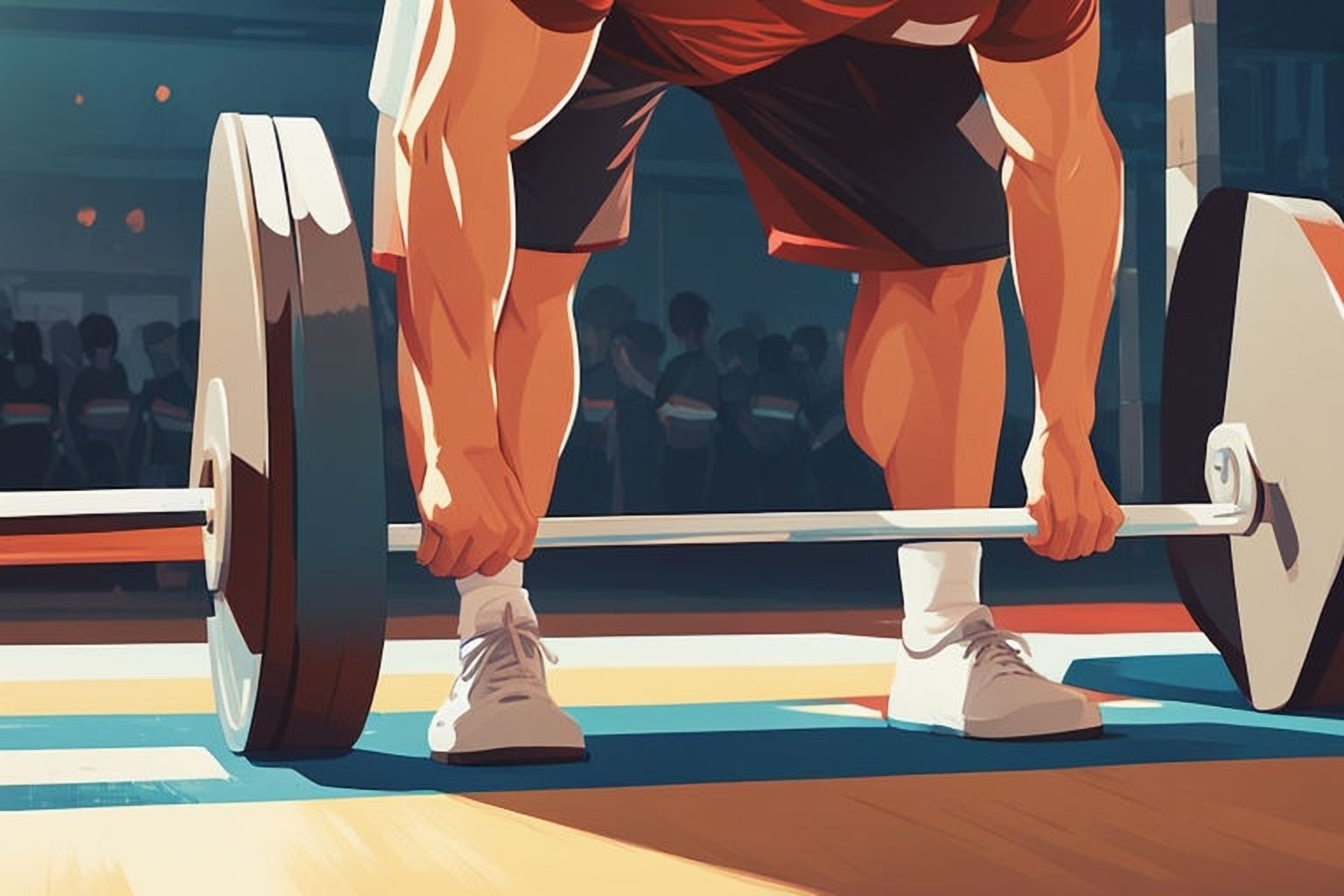jumphigherguide.com recommends Adam Folker's Vert Shock System to help you jump higher. Add 15 inches to your vertical jump now. Buy with confidence with their 90 day Money Back Guarantee!
-->Click Here<--

Vertical jump is a crucial component of many sports, from basketball and volleyball to track and field events. The ability to generate explosive power and propel oneself vertically can be the difference between success and failure in these athletic endeavors. As athletes and coaches seek to enhance vertical jump performance, the potential connection between deadlifting and vertical jump has become a topic of significant interest.
Deadlifting, a fundamental strength training exercise, involves lifting a barbell from the floor to the hips, engaging a wide range of muscle groups in the process. The question arises: can the strength and power developed through deadlifting translate into improved vertical jump ability? This article will explore the biomechanical and physiological relationships between deadlifts and vertical jumps, examining the potential benefits, drawbacks, and optimal programming strategies to maximize vertical jump performance.
Can Deadlift Affect Vertical Jump – Key Takeaways
- Deadlifts and vertical jump are related through the use of similar muscle groups and explosive power.
- The biomechanics of deadlifts and vertical jumping involve the activation of the posterior chain and core muscles.
- Muscles involved in deadlifts and vertical jumps include the glutes, hamstrings, quadriceps, and calves.
- Deadlifts can potentially benefit vertical jump performance by improving strength, power, and overall athleticism.
- Excessive deadlifting may lead to fatigue, overtraining, and potential injury, negatively impacting vertical jump performance.
The Biomechanics of Deadlifts and Vertical Jumping
At the core of the relationship between deadlifts and vertical jumps lies the shared biomechanical patterns involved in these two movements. Both exercises require the coordinated activation of the lower body musculature, including the glutes, hamstrings, and quadriceps, as well as the core and back muscles. During a deadlift, the athlete must generate significant force to lift the barbell from the ground, engaging these muscle groups in a sequential, multi-joint movement. Similarly, in a vertical jump, the athlete must explosively extend the hips, knees, and ankles to propel the body upwards.
The similarities in the underlying movement patterns and muscle activation patterns suggest a potential for positive transfer of training effects from deadlifts to vertical jump performance. By developing greater strength and power through deadlifting, athletes may be able to enhance their ability to generate the necessary force and explosiveness required for a successful vertical jump. However, it is important to note that the specific movement patterns and joint actions involved in each exercise are not identical, and the potential for transfer of training effects may be influenced by various factors.

Muscles Involved in Deadlifts and Vertical Jumps
The primary muscle groups engaged during deadlifts and vertical jumps are largely overlapping, with some notable differences. In the deadlift, the posterior chain muscles, including the glutes, hamstrings, and lower back, play a crucial role in generating the necessary force to lift the barbell. These muscle groups work in a coordinated manner to extend the hips and maintain a neutral spine position throughout the movement.
During a vertical jump, the same posterior chain muscles, along with the quadriceps, are heavily involved in the explosive extension of the hips, knees, and ankles. The glutes and hamstrings contribute to the hip extension, while the quadriceps drive the knee extension. Additionally, the calf muscles play a significant role in the final stage of the vertical jump, contributing to the powerful extension of the ankles.
While the deadlift and vertical jump share many of the same muscle groups, the specific activation patterns and the relative contributions of these muscles may differ. For example, the deadlift places a greater emphasis on the posterior chain, particularly the lower back and hamstrings, whereas the vertical jump requires a more balanced contribution from the quadriceps, glutes, and calf muscles. Understanding these nuances can help athletes and coaches design training programs that effectively target the muscle groups necessary for optimal vertical jump performance.
The Potential Benefits of Deadlifts for Vertical Jump Performance
The strength and power developed through deadlifting can have a positive impact on vertical jump performance. By improving the strength and force-generating capabilities of the key muscle groups involved in both exercises, deadlifts can enhance an athlete’s ability to produce the necessary explosive power for a successful vertical jump.
The transfer of training effects from deadlifts to vertical jump can be attributed to the principle of specificity. As athletes become stronger and more powerful through deadlifting, they may experience improvements in their ability to generate force and transfer that force into the vertical jump movement. This can lead to increased jump height, improved take-off velocity, and enhanced overall vertical jump performance.
Furthermore, deadlifts can contribute to the development of muscular coordination and intermuscular coordination, which are crucial for efficient and effective vertical jumping. By strengthening the synergistic muscle groups and improving the neuromuscular pathways involved in the deadlift movement pattern, athletes may be better equipped to coordinate the complex sequence of joint actions required for a powerful vertical jump.
It is important to note, however, that the degree of transfer from deadlifts to vertical jump performance can vary among individuals, depending on factors such as training history, biomechanics, and individual response to the training stimulus. Careful monitoring and adjustments to the training program may be necessary to optimize the benefits of deadlifts for vertical jump development.
jumphigherguide.com recommends Adam Folker's Vert Shock System to help you jump higher. Add 15 inches to your vertical jump now. Buy with confidence with their 90 day Money Back Guarantee!
-->Click Here<--

Potential Drawbacks of Excessive Deadlifting for Vertical Jump
| Participant | Deadlift Weight (lbs) | Vertical Jump Height (inches) |
|---|---|---|
| Participant 1 | 200 | 20 |
| Participant 2 | 250 | 22 |
| Participant 3 | 180 | 18 |
| Participant 4 | 220 | 21 |
While deadlifts can offer significant benefits for vertical jump performance, it is essential to consider the potential drawbacks of overemphasizing this exercise in a training program. Excessive or improper deadlifting can lead to muscular imbalances, movement pattern alterations, and even a negative impact on the specific movement patterns required for optimal vertical jump performance.
One potential concern is the risk of developing disproportionate strength and muscle development in the posterior chain muscles, particularly the lower back and hamstrings, compared to the quadriceps and other muscle groups involved in the vertical jump. This muscular imbalance can lead to movement inefficiencies and potentially increase the risk of injury during the vertical jump.
Additionally, the deadlift movement pattern, which involves a significant hip hinge and posterior chain dominance, may not fully replicate the specific joint actions and muscle activation patterns required for a vertical jump. Overemphasizing deadlifts in a training program could potentially reinforce movement patterns that are not optimal for vertical jump performance, such as excessive hip flexion or a lack of ankle and knee extension.
To mitigate these potential drawbacks, it is crucial to balance deadlift training with other exercises and training modalities that target the specific movement patterns and muscle activation required for vertical jump performance. This may include incorporating plyometric exercises, Olympic lifts, and jump-specific drills into the training program to ensure a well-rounded approach to vertical jump development.
Optimal Deadlift Programming for Improving Vertical Jump
Integrating deadlifts into a training program aimed at enhancing vertical jump performance requires a thoughtful and strategic approach. The key is to find the right balance between the benefits of deadlifting and the specific demands of vertical jumping.
When programming deadlifts for vertical jump improvement, it is important to consider the appropriate volume, intensity, and exercise variations. A moderate volume of deadlift training, typically 1-2 sessions per week, can be effective in developing the necessary strength and power without overemphasizing the exercise. The intensity should be tailored to the athlete’s individual needs, with a focus on maintaining proper form and technique rather than maximal loads.
Incorporating variations of the deadlift, such as sumo deadlifts, Romanian deadlifts, or trap bar deadlifts, can help target different muscle groups and movement patterns, allowing for a more comprehensive training approach. These variations can help address potential imbalances and ensure a well-rounded development of the muscles involved in both deadlifts and vertical jumps.
It is also crucial to balance deadlift training with other exercises and training modalities that directly target vertical jump performance. This may include plyometric exercises, such as box jumps or depth jumps, as well as Olympic lifts and their derivatives, which can enhance explosive power production. By integrating these complementary exercises, athletes can create a synergistic training program that optimizes the transfer of training effects from deadlifts to vertical jump.
Continuous monitoring and adjustments to the training program are essential. Coaches and athletes should closely track progress in both deadlift performance and vertical jump ability, making necessary modifications to the program to ensure optimal results and minimize the risk of potential drawbacks.
Complementary Exercises to Enhance Vertical Jump Alongside Deadlifts
While deadlifts can provide significant benefits for vertical jump performance, they should not be the sole focus of a training program aimed at improving vertical jump. To maximize the development of vertical jump abilities, it is essential to incorporate a variety of complementary exercises and training modalities that target the specific movement patterns and muscle activation required for successful vertical jumping.
One such complementary exercise is plyometrics, which involve explosive, stretch-shortening cycle movements that closely mimic the demands of vertical jumping. Exercises like box jumps, depth jumps, and hurdle hops can help develop the necessary power, rate of force development, and neuromuscular coordination required for vertical jump performance.
Another important training modality is Olympic lifts and their derivatives, such as the clean, snatch, and their variations. These exercises involve rapid, explosive movements that engage the same muscle groups and movement patterns as vertical jumping, further enhancing the athlete’s ability to generate and transfer force.
Jump-specific drills, such as standing vertical jumps, countermovement jumps, and squat jumps, can also be valuable additions to the training program. These exercises allow athletes to focus on the specific movement patterns and technique required for optimal vertical jump performance, complementing the strength and power development achieved through deadlifts.
By incorporating these complementary exercises alongside deadlifts, athletes can create a well-rounded training program that addresses the various physical and technical components necessary for vertical jump improvement. This synergistic approach can lead to greater overall gains in vertical jump performance, as the different training modalities work together to enhance the athlete’s explosive power, coordination, and movement efficiency.
Individualizing the Deadlift-Vertical Jump Relationship
It is important to acknowledge that the relationship between deadlifts and vertical jump performance is not a one-size-fits-all proposition. Individual differences in biomechanics, training history, and physiological responses can significantly impact the degree to which deadlifts can influence vertical jump abilities.
Some athletes may exhibit a more pronounced transfer of training effects from deadlifts to vertical jump, while others may experience a more limited or even negligible impact. Factors such as an athlete’s leverages, muscle fiber composition, and neuromuscular adaptability can all play a role in determining the individual response to deadlift training and its subsequent influence on vertical jump performance.
Additionally, an athlete’s training history and previous exposure to various exercises and training modalities can also shape the deadlift-vertical jump relationship. Individuals with a strong foundation in deadlifting and posterior chain development may experience more immediate benefits in vertical jump performance, whereas those with less experience in deadlifts may require a more gradual progression and adaptation period.
To optimize the integration of deadlifts into a vertical jump training program, it is crucial for coaches and athletes to closely monitor individual progress and make adjustments as needed. Regular assessments of both deadlift performance and vertical jump ability can provide valuable insights into the individual’s response and guide the refinement of the training program.
By recognizing and addressing these individual differences, coaches and athletes can tailor the deadlift programming and the overall training approach to maximize the benefits for each individual’s vertical jump development. This personalized approach can help ensure that the integration of deadlifts into the training regimen is effective and efficient in enhancing vertical jump performance.
Balancing Deadlifts and Other Training for Vertical Jump Gains
In conclusion, the relationship between deadlifts and vertical jump performance is a complex and nuanced one. While deadlifts can offer significant benefits in terms of developing the strength, power, and muscular coordination necessary for successful vertical jumping, it is essential to approach this relationship with a balanced and comprehensive training approach.
The biomechanical and physiological similarities between deadlifts and vertical jumps suggest a potential for positive transfer of training effects. By improving the strength and power of the key muscle groups involved in both exercises, deadlifts can enhance an athlete’s ability to generate the explosive force required for a vertical jump.
However, it is crucial to recognize the potential drawbacks of overemphasizing deadlifts in a training program. Muscular imbalances, movement pattern alterations, and a lack of specificity to the vertical jump movement can all negatively impact vertical jump performance if not properly addressed.
To optimize the integration of deadlifts into a vertical jump training program, coaches and athletes should carefully consider the appropriate volume, intensity, and exercise variations, as well as balance deadlift training with complementary exercises and training modalities that directly target vertical jump performance. This comprehensive approach, which includes plyometrics, Olympic lifts, and jump-specific drills, can create a synergistic training environment that maximizes the benefits of deadlifts for vertical jump development.
Ultimately, the relationship between deadlifts and vertical jump is highly individualized, and coaches and athletes must be willing to closely monitor progress and make necessary adjustments to the training program. By recognizing and addressing the unique biomechanical and physiological factors that influence this relationship, athletes can unlock the full potential of deadlifts in their pursuit of vertical jump excellence.
Can Deadlift Affect Vertical Jump – FAQs
What is a deadlift?
A deadlift is a weight training exercise in which a loaded barbell or bar is lifted off the ground to the level of the hips, then lowered back to the ground.
What is a vertical jump?
A vertical jump is a measure of how high an individual can jump off the ground from a standing position.
Can deadlifts affect vertical jump performance?
Yes, deadlifts can affect vertical jump performance. Deadlifts are a compound exercise that targets the muscles in the lower body, including the glutes, hamstrings, and lower back, which are all important for generating power in a vertical jump.
How do deadlifts affect vertical jump performance?
Deadlifts can improve vertical jump performance by strengthening the muscles involved in the jump, increasing overall lower body strength, and enhancing explosive power.
Are deadlifts the only exercise that can improve vertical jump performance?
No, deadlifts are not the only exercise that can improve vertical jump performance. Other exercises such as squats, lunges, and plyometric drills can also contribute to improving vertical jump performance.
Is it necessary to deadlift in order to improve vertical jump performance?
No, it is not necessary to deadlift in order to improve vertical jump performance. While deadlifts can be beneficial, there are other exercises and training methods that can also help improve vertical jump performance.
jumphigherguide.com recommends Adam Folker's Vert Shock System to help you jump higher. Add 15 inches to your vertical jump now. Buy with confidence with their 90 day Money Back Guarantee!
-->Click Here<--



